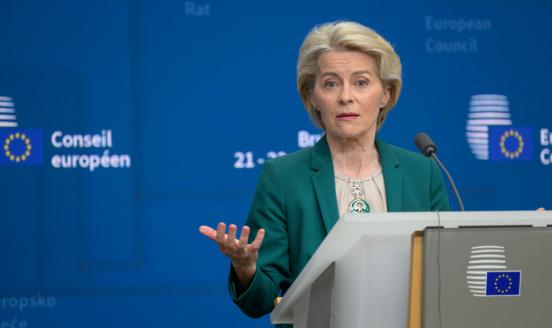Deepening the economic and monetary union
Commissioner Moscovici's speech at the Bruegel event "Deepening the economic and monetary union"
Thank you for inviting me at Bruegel. I’m very happy to have the occasion to speak here for the first time since I moved to Brussels in November.
Let me begin by saying how useful high quality and truly European think tanks like Bruegel are, for the quality of policy making and democracy in Europe.
I am very much looking forward to good intellectual cooperation and exchange with think tanks over the mandate of this Commission, and in particular in the field of Economic and financial affairs.
I have been asked to give my views on how « Deepening the EMU » could take place over the coming months and years. Therefore, I will express my personal ideas, which does not necessarily reflect the views of the European Commission.
The economic and monetary union architecture was quite substantially reinforced over the last five years, in response to the crisis.
As you know, the economic and monetary union architecture was quite substantially reinforced over the last five years, in response to the crisis, and most of the time without the luxury of time to design and implement optimal solutions. The priority was to stabilize the EMU – and that was right and was largely achieved.
We are now entering a new period where the acute phase of the crisis is over. We can now take the time to take stock of our past actions, and think about how to design a permanently stable and balanced EMU.
The time of firefighters is behind us, now is the time for architects. This is not a reflection for the months to come, it is a reflection for the years to come. My conviction is that this work is absolutely necessary.
We are the Commission of the last chance – we have to deliver to secure the legitimacy of the European project. Of course, this means acting today – what we have done in the last two months is already very substantial (Juncker Plan, flexibilities, Greece…). But this means also thinking about tomorrow.
Maybe this Commission will only lay ground for future changes under future Commissions – but this Commission cannot stay idle, we have to show the way.
A mandate was given to the « four presidents » by the October Euro summit to prepare next steps on better economic governance in the euro area. The Commission’s Blueprint for a Deep and Genuine EMU, as published in November 2012, remains an important basis for the work in this regard.
But please let me share more personal views on how we should prepare the needed changes.
The first important pillar is a shared understanding of what went wrong in the crisis, and in the response to the crisis
The first important pillar is a shared understanding of what went wrong in the crisis, and in the response to the crisis. It is time, now that a new team is in charge, to have a lucid and critical look into the past.
The second step is to agree on the main broad features a balanced and sustainable EMU should possess over the medium run.
Only then, can we envisage a multistage process to move towards genuinely deepening the EMU.
Short term reactions will not lead to satisfactory outcomes.
All the ambitious and successful endeavors of the European integration have taken place over long periods of time but with a clear view to where we were heading. The initial EMU was designed and implemented this way over ten years.
Deepening the EMU will not happen overnight. The method of small steps, advocated by Monnet, might still be the right approach, but it cannot be the alibi for unclear end goals.
Over the past years the EU has been experiencing the largest crisis since the nineteen thirties. Euro area GDP saw an unprecedented drop of 4.4% in 2009 and recovery of the EU economy since the recession in 2008-09 has been slower than any other recovery in the post-World War II period, on both sides of the Atlantic.
The crisis in the euro area has seen great depths, with euro area Member States losing market access and entering into emergency assistance programs, and even fears about a euro area breakup.
Overall we are just exiting six years of average almost zero growth…
With hindsight it is now clear that the flawed setup of Economic and Monetary Union contributed to the emergence and depth of the crisis.
With hindsight it is now clear that the flawed setup of Economic and Monetary Union contributed to the emergence and depth of the crisis.
The original EMU setup – developed under the Maastricht Treaty – consisted of a common monetary policy under the European Central Bank, combined with national decision-making on fiscal issues.
The framework is the Stability and Growth pact, an open method of coordination for national economic policies, financial market supervision and regulation remaining a competence of the national level.
When launching the euro, it was generally assumed that the single currency would foster growth. While there were doubts whether the euro area was an optimum currency area, it was believed that the euro itself would increase cyclical convergence.
Also, many believed that the euro would bring further convergence in Member States’ economic structures and policies and that it would fuel cross-border integration and growth. While the euro has indeed created some positive integration effects (for instance on trade and prices), forces of divergence prevailed.
In a nutshell, the crisis exposed important deficiencies in the structure of the EMU. The EMU governance failed on two accounts: effective crisis prevention and effective crisis resolution.
Lack of effective crisis prevention
The EMU setup proved unable to incentivise the build-up of fiscal buffers in good times.
Excessive risk taking in the private sector, macroeconomic imbalances and asset prices bubbles were able to develop unchecked and spilled over through the financial sector.
While economic cycles seemed to converge in the early years of the euro, the underlying divergence was masked by the build-up of imbalances and was revealed in the presence of a common exogenous shock, the US imported financial crisis.
Structural reform implementation did not pick up – this hampered efficient resource allocation, contributed to building imbalances, which aggravated the crisis. Now it is slowing down the recovery by hampering adjustment.
Lack of effective crisis resolution
Insufficient mechanisms were in place to deal with financial instability within the single currency. Contagion between fragile sovereigns could not be prevented: no effective firewall was in place.
Insufficient mechanisms were in place to deal with financial instability within the single currency
Strong feedback loops emerged between sovereign and financial sectors, encouraging financial market fragmentation along national borders: no supranational financial resolution mechanism was in place.
Now let me turn to the response to the crisis. What has been done is known – but I believe we still miss a precise assessment of the efficiency of our response. This is normal as we may have too little distance.
In late November, the Commission published a first assessment of the Six and Two Packs – this is part of the necessary analysis of our crisis response. This is work in progress. There by the way we importantly need input from academia!
Important progress has been made so far on various fronts and has contributed to stabilising the situation, specifically in the financial sector with the establishment of a Banking Union:
- Strengthening the integration and stability of the financial sector: a single European rule book and macro- and micro-prudential surveillance; a Single Supervisory Mechanism (entry into force November 2014) and Single Resolution Mechanism (entry into force January 2015).
- These steps together with the parallel clean-up of bank balance sheets will alleviate the accumulation of risks in financial/banking sectors and help preventing fragmentation of the EU financial system in times of crisis.
- Improving crisis resolution: with the European Stability Mechanism we now have a permanent tool for crisis management with sufficient financial backstop.
- Preventing and correcting imbalances, stimulating adjustment and increasing competitiveness: the 6-pack and 2-pack legislation in principle provides better tools for macro-structural surveillance.
But the results are not there yet in terms of growth – which points to the still very imperfect organization of the EMU and the poor quality of policies within the EMU. Let me quickly point to some of the symptoms.
In 2015, the recovery enters its third year, but it has not been able to break out of the slow growth pattern that has defined it since its onset.
- Adjustment mechanisms remain weak.
- Deleveraging of private and public households is unfinished.
- Very low inflation is making debt reduction and the adjustment of relative prices more difficult.
- Employment growth that has been too weak to lower unemployment significantly.
- Low investment has been a key reason for the euro area’s weak growth. Investment is still about 15% below its pre-crisis peak
Within this weak recovery substantial differences exist in economic performance between the Member States. They prevent the smooth functioning of the euro area by making the single monetary policy less effective.
At the end of the day it might even undermine citizens’ trust in the EMU and support for the euro as a common project.
At the same time, the crisis has exposed how demanding it is for Member States to belong to the EMU in terms of national policies:
- The rebalancing of growth in a monetary union is possible only if structural reforms are implemented;
- Member states find it hard to do and the Union as a whole has also found hard to encourage in a effective manner with the right sticks and carrots…
We cannot claim that the job is done with fixing the EMU.
In my view these symptoms reveal that we cannot claim that the job is done with fixing the EMU.
One of the reasons is that the response to the crisis should have implied two series of actions:
- first: take the Eurozone out of the present crisis;
- second: prepare the Eurozone for the « next » crisis – make it more resilient
In fact, these two agenda may be partially contradictory and what we did, is a bit of both. We have to make a clear distinction.
What are the features of a balanced and sustainable EMU?
To make the EMU stable in the short term we need to return to growth
To make the EMU stable in the short term we need to return to growth.
Structural, fiscal and monetary policies have to be combined in an integrated, approach to tackle the current challenges effectively.
We have to act both on the demand and supply sides. To me it is today absolutely evident that we have a problem of aggregate demand in the Eurozone. It is also absolutely clear that deep reforms are needed in the Member states and in the Union.
Action should be centred around three priorities:
- A coordinated boost to investment: the Commission’s investment plan, published on 26 November, should mobilise at least EUR 315 billion of additional public and private investment over the period 2015-2017 and improve significantly the overall investment environment.
- A renewed commitment to structural reforms focussing on progress both at national and EU level. At national level emphasis should lie for instance on labour and product market reforms and improving conditions for business to create new opportunities for jobs and growth. At EU level progress is needed in the single market for services, energy, telecoms and the digital economy.
- Pursuing fiscal responsibility: without downplaying the achievements so far, most of the Member States still need to secure long term control over deficit and debt levels. I am convinced that Member States with more fiscal space should take measures to encourage domestic demand, with a particular emphasis on investment. Moreover, and most importantly, the quality of public finances should be raised everywhere.
The Commission has last week provided further guidance on the best possible use of the flexibility that is built into the existing rules of the Stability and Growth Pact. This shows the integrated nature of our policy advice and our pragmatism within existing rules. These rules might be imperfect. But they are a condition for trust among Member states, their stability makes economic sense – they have to be respected.
For the medium and long term, the challenges on the path towards the « genuine EMU » should not be underestimated.
For the medium and long term, the challenges on the path towards the « genuine EMU » should not be underestimated, as they include such vital question as changes in the EU Treaties or addressing the problem of the legacy debt.
To my mind, changes in secondary legislation and possibly the Treaty can be envisaged down the road.
In such an environment, important additional steps can be taken to further improve convergence and adjustment capacity within the EMU. A number of elements should notably come to the fore:
- Streamlining and integrating economic and budgetary coordination processes
Consideration could be given to simplifying the rather complex existing surveillance structures to move away from the « silo » approach (fiscal, imbalances governed by separate processes which do not interact). More attention should also be paid to the euro-area specificities, such as spillovers and the aggregate policy stance.
I am convinced that transparency and simplicity should drive any improvement of the rules, and democratic accountability should be reinforced where there are executive discretionary powers for the Commission.
- Strengthening the tools to incentivize structural reforms at the national level
Taking better into account structural reforms in the implementation of the SGP as suggested in the recent Commission communication on flexibility is such an example.
- Moving towards an EMU-level adjustment mechanism, e.g. in the form of a euro area fiscal capacity, while acknowledging room for fiscal subsidiarity
A common fiscal capacity is a common feature of other monetary unions. It may serve purposes such as supporting macroeconomic stabilisation and insurance against shocks, or providing public goods (e.g. defence or internal security).
To me, setting up such a fiscal capacity, possibly with own resources and/or borrowing capacity at European area or European union level will have far reaching economic and legal implications.
In particular, I believe that they will imply a qualitative step forward in terms of democratic control of central European executive powers.
- Improving democratic legitimacy and accountability
The democratic legitimacy and accountability for economic policy in the EU could be further enhanced in particular by ensuring the adequate involvement of the European Parliament and the national parliaments.
In the present state of distrust of citizens towards « Brussels » it is absolutely key if we need more integration, more intrusion of the « center » into somes of the policies of Member states.
This notably includes the area of crisis resolution, where in the context of programme surveillance, I think that the “troika” should be replaced with a more democratically legitimate and more accountable structure, based around European institutions with enhanced parliamentary control both at European and at national level. This is of course not a reproach to the « troika » which was very helpful. But now we must go further.
- Preparing the Commissioner for Economic and Financial Affairs to become the Finance Minister of the Eurozone
To prepare this evolution, closer and more integrated work by the ECFIN and TAXUD DGs are a first step.
In due course the question of the integration of the Eurogroup President within the Commission will have to be on the table, bit this issue is for the long run.
- A more efficient external representation of Economic and Monetary Union
The euro is the second most important currency in the world, but the fragmented external representation of the euro in international economic matters means that the euro area is punching below its weigh. There is a room for improvement and the Commission intends to come with a proposal in this regard still this year.
***
Ladies and gentlemen,
More solidarity between member states, more responsibility of member states, rules when possible, discretion of executive decisions when necessary, control by state of the art democratic bodies all the time.
I have given you the general directions I personally believe should be those of a genuine, sustainable and balanced EMU in the long run: more solidarity between member states, more responsibility of member states, rules when possible, discretion of executive decisions when necessary, control by state of the art democratic bodies all the time.
Obviously these goals are not achievable now, or even in a couple of years. But this is not a reason to renounce. Because I am truly convinced that we need a more integrated Union, in particular in the Economic and Monetary dimension, and because I am truly convinced that the role of Commissioners is also to prepare a better functioning Europe for our children.
Thank you.
Visit the page of the event for to view the full recording



